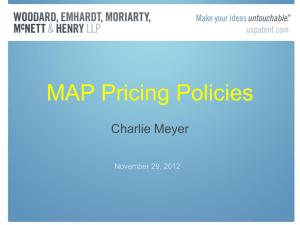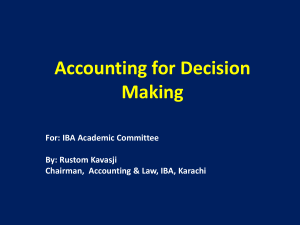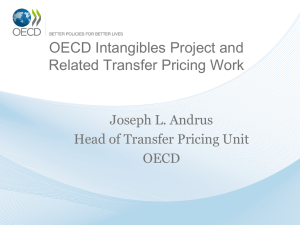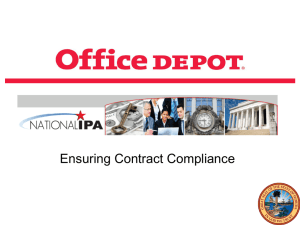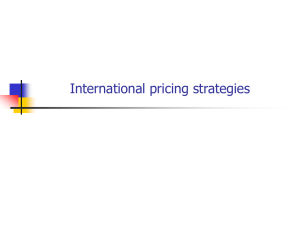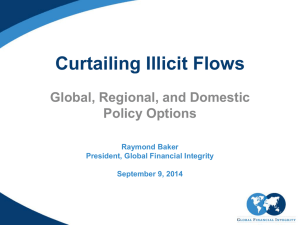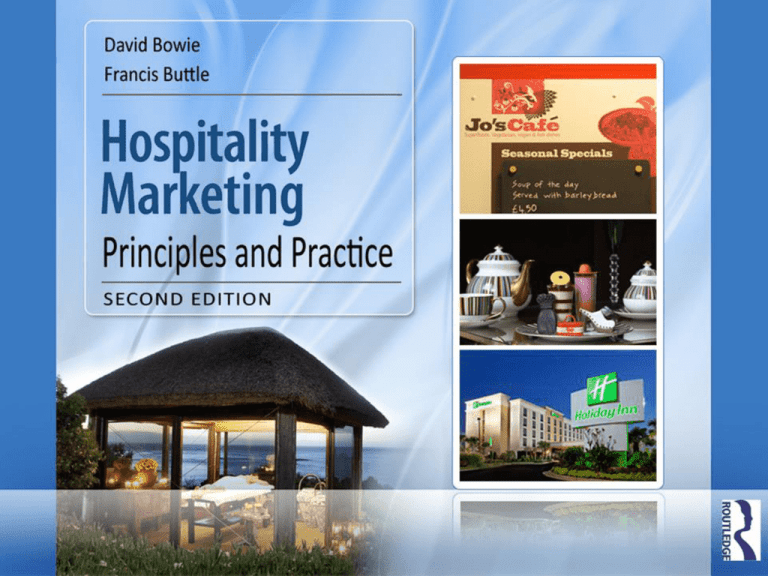
Chapter 7
Pricing the offer
Understand the significance of pricing in the preencounter marketing mix
Identify external and internal factors that influence
pricing decisions
Appreciate how online search and transparency
influences contemporary pricing strategies
Explain quality/pricing strategies in a hospitality context
Understand how hospitality organizations set price
Describe the practice of dynamic pricing and its role in
optimizing revenue
Describe the role of price promotions to increase
revenue in low demand periods
Recognize the complexity of pricing in an international
context
Pricing is the tool that matches supply and demand
Price influences the demand for a product, which in turn
determines volume sales
Therefore, setting an appropriate price is one of the most
important factors in demand management and in
generating revenue
Revenue management (RM) is the tool used to manage
demand through flexing prices in medium and large-sized
accommodation businesses
Price is the only element of the marketing mix that does
not generate costs, but price is also the only element of
the marketing mix to generate revenue
Price is defined as ‘the summation of all sacrifices made
by a consumer in order to experience the benefits of a
product’
This definition includes both financial and other sacrifices
Different types of hospitality products and different sizes
of businesses have different approaches to pricing
decisions
Large conference, event and hotel companies, and many
large independent hotels use dynamic pricing and
complex revenue management systems, with
sophisticated databases and online booking to manage
real-time availability and pricing decisions
Influence of the Internet and online technologies has
challenged conventional approaches to pricing and
introduced more complexity to price decisions for these
companies
Smaller accommodation businesses and bar, café and
restaurant operations use more traditional fixed-price
menus and tariffs
There is a clear link between the price a customer pays
and the customer’s quality expectations
The higher the price, the greater the expectations of a
high-quality hospitality experience
Price is an indicator and a measure of quality, particularly
in the absence of other cues
Price plays an important part in establishing customers’
perceptions of a product and of a company’s or brand’s
position in the marketplace
Price is the easiest variable to change in the marketing
mix, but is often thought of as the most complex
Factors that influence price decisions can be sorted into two
major categories:
External environmental factors – over which companies
have little (if any) control
Internal factors – over which companies have a
considerable amount of control
Figure 7.1 Factors that influence pricing decisions
The sales volume of a product that has inelastic price
demand does not vary significantly when price changes:
essential purchases are price inelastic
The sales volume of a product that has an elastic price
demand varies significantly when prices change:
non-essential purchases are more price elastic
The business cycle has significant impact on business
and consumer confidence and pricing
During periods of economic growth, rising confidence
and less price sensitivity from business and consumers
and less resistance to price increases
During a recession, the loss of business and consumer
confidence significantly reduces demand and companies
respond by flexing prices downwards
Different hospitality sectors have different cost structures,
which impact pricing strategies
Luxury hotels require a high investment in the building,
décor, facilities and staffing ratios
The pricing strategies of the five-star hotel sector must
reflect the higher investment and operating costs
The luxury sector has more potential for price flexibility
given the relatively high rack rates
Budget hotels which are constructed with pre-fabricated
standardized bedrooms, in secondary locations, offering
minimal staffing levels and no ancillary facilities
The pricing strategies of the budget sector should reflect
the lower investment and operating costs
The budget sector has limited ability to flex prices due to
the relatively low rack rate
Prestige pricing
Luxury operations adopt a ‘prestige’ or premium pricing objective (i.e.
to charge high prices for the top-quality service) and must give the
customer a service that matches the premium prices charged
Value-for-money
Many hospitality operators adopt a ‘best value for money’ objective in a
given product class
To succeed they need to scan competitors’ prices and ensure that their
offer delivers the best perceived value for money
Trial or repeat purchase
Another marketing-orientated pricing objective is to encourage trial or
repeat purchases
A new hospitality concept needs to generate interest and one of the
tools used is a free drink/meal or discounted trial purchase
Repeat visits are encouraged by promotions and loyalty club offers
Survival
Target return on investment (ROI)
Skimming
Harvesting
Cost-orientated pricing objectives
Maximizing sales revenues
Penetration pricing strategy
Volume
Tactical pricing
A major factor in pricing decisions is the cost of
producing and marketing the product
Fixed costs do not vary with sales volume – rent, property
taxes, permanent staff, repayment of loans/interest
Variable costs vary in proportion to sales – examples
include food/beverage purchases, laundry services
Semi-fixed costs vary in sympathy with, but not in
proportion to, sales volume – examples include energy
costs (light, heat, air-conditioning) and part-time wages
The prices set must eventually recover the long-term
total costs of running the business
Two main distribution models in tourism: the ‘agency’ model
and the ‘merchant’ model
Agency model:
Hospitality companies pay a travel agent or online
intermediary a fixed commission for each booking
Minimum commission paid to travel agents is 8% and the
norm varies between 10% and 25%
Merchant (or wholesaler) model:
Intermediary negotiates an allocation of inventory
(cabins, rooms, seats) at an agreed rate from the
hospitality operator
Discounts for a contract rate vary from 15% to 65% off
the rack rates
Market leader strategies
Well-established hotel companies with a loyal customer base, a
strong brand image and high levels of repeat business adopt a
market leader strategy where the prices are aligned with the
brand’s quality and positioning
Market follower strategy
New entrants and less-established hotel brands, seeking to build
market share by penetration pricing, adopt a market follower
strategy, which pitches prices lower than the market leader
Unsustainable strategy
Some hotels implement over-priced strategies compared with
their competitor sets and market conditions, which are
unsustainable as a long-term proposition. These companies
charge rates higher than the quality can justify. Overtime
customers will recognize the poor value for money, and the
reputation of the business will suffer
Market-led
The highest price that customers are willing to pay; considers the
competition, demand and profitability, and sets the ceiling for prices
Competitor-led
Prices simply follow competitors; fails to take into account customers’
willingness to pay, return on investment goals and company costs
Profit-led
Return on investment target provides internal goals to motivate
managers; fails to take into account customers and competitors
Cost-led
Cost-based pricing sets the floor for prices; fails to take into account
customers’ willingness to pay and return on investment goals, is
sometimes used to establish the lowest pricing level that a company
can charge to remain viable
Hospitality companies have adopted computerized yield
management systems to maximize their potential
revenue by controlling inventory and using price as a
demand management tool
Known as revenue management (RM), this is a complex
form of price discrimination
Dynamic pricing flexes prices to match forecast demand
with current available capacity
Prices change according to the probability of selling the
last rooms and are influenced by length of time between
the date of booking and the date of arrival, customer
demand and different customer segments’ willingness
Online technology changed consumer buying behaviour and hospitality
companies’ response
Transparent pricing, online comparative shopping, sophisticated databases,
data management techniques
Online prices are flexed using the Best Available Rate (BAR)
The BAR is the best rate a customer can book at the time of booking and is
determined by the estimated value of the last rooms to sell
The BAR fluctuates as the RMS recalculates forecast demand and changes
the BAR on a periodic basis (e.g. for every 12 hours)
Companies using RM no longer publish online fixed prices; instead rate
bands from high to low indicate the likely range of prices to potential
customers
Contract corporate, aircrew and group negotiated rates have fixed rates or
are discounted from the BAR and fluctuate with the BAR
One consequence is the requirement to overbook
Price promotions need carefully planning to protect revenue streams from
the core business and not devalue brand image
Hotels offering low demand price promotions ‘rate-fence’ the promotion
by having pre-booking conditions (rate restrictions)
Price led promotions should make a realistic contribution towards
overheads and justify the marketing cost of the promotion
Popular promotions include ‘two for the price of one’ or BOGOF (buy one,
get one free)
Price-led promotions help to boost sales in quiet periods and should
attract new customers who are expected to return and pay the normal
price
Many customers who enjoy a promotional price do not return and there is
also the danger of ‘cannibalizing existing customers’; loyal customers may
take advantage of the price promotion and business suffers a reduction in
sales and profits
All sectors of the industry bundle a package of benefits at
an all inclusive price
Examples include foreign package holidays, activity
leisure breaks, 24 hour conference delegate packages,
wedding receptions and fast-food and drink
combinations.
The advantages of product bundling for the consumer
include the perception of added value (indeed, really
effective packages do provide customers with added
value) and the ease of booking all the components of the
bundle at one price in one transaction
Difficulties in setting a pricing strategy for companies operating
in more than one country include:
different currency and cost structures between countries
different types of competitors – global, regional, national
branded chains and local independents
different stages of the market/product life cycle in each
country
different inflation rates and exchange rates
ability to repatriate profits varies significantly from country
to country
Companies aiming to promote and protect their hospitality
brands by standardizing the product offer, a uniform price
position presents particular problems
A pricing strategy can be consistent, for example adopting a
market leader strategy and charging the highest prices in the
competitor set, however the actual price charged will vary
between different countries
Customers decide whether the company is charging the right price
Although pricing decisions are the easiest element of the marketing mix
to change, they remain a complex phenomenon
Pricing is the tool that matches supply and demand
That price is the only element of marketing mix that does not generate
cost; price generates revenue
That price, in the absence of other cues, is an indicator of quality and
sets customer expectations
Companies have little control over the external factors that influence
pricing decisions, but considerable control over the internal factors that
influence pricing decisions
How the Internet has transformed consumer awareness of comparative
hospitality products and transparent prices
Why pricing decisions should reflect market positioning
That medium and larger accommodation-based businesses use dynamic
pricing strategies and RMSs to drive revenue
Price promotions, linked to product benefit bundles, are extensively
used to grow revenue in low-demand periods
International pricing decisions are subject to local country
environmental factors
Burgess, C. (2010). Essential Financial Techniques for Hospitality Managers: A
Practical Manual. Goodfellow Publishers.
Cross, R. (1997). RM: Hard-core Tactics for Market Domination. Broadway Books.
Harris, P. J. and James, P. (1999). Profit Planning. Butterworth-Heinemann.
Ingold, A., McMahon-Beattie, U. and Yeoman, I. (2000). Yield Management:
Strategies for the Service Industries (2nd ed.). Cassell.
Kimes, S. E. (2008). ‘The role of technology in restaurant revenue management’.
Cornell Hospitality Quarterly, 49, pp. 297–309.
Kotler, P., Keller, K., Brady, M., Goodman, M. and Hansen, T. (2009). Marketing
Management. Pearson Prentice Hall.
Noone, B. M. and Mattila, A. S. (2009). ‘Hotel revenue management and the
Internet: the effect of price presentation strategies and customers’ willingness to
book’. International Journal of Hospitality Management, 28, pp. 272–279.
Talluri, K. T. and Van Ryzin, Garrett. (2005). The Theory and Practice of Revenue
Management. Springer.
Tranter, K. A., Stuart-Hill, T. and Parker, Juston. (2008). An Introduction to Revenue
Management for the Hospitality Industry. Prentice Hall.
Varini, K., Englemann, R., Claessen, B. and Schleusenier, M. (2003). ‘Evaluation of
the price-value perception of customers in Swiss hotels’. Journal of Revenue and
Pricing Management, 2 (1), pp. 47–60.
Yeoman, I. and MacMahon-Beattie, U. (2004). Revenue Management and Pricing:
Case Studies and Applications. Thomson Learning.

